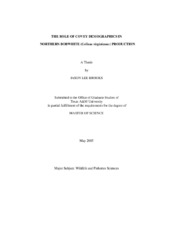| dc.description.abstract | Northern bobwhite (Colinus virginianus) populations are irruptive along their western periphery. Previous research has failed to identify the factors associated with these irruptions, but precipitation is often assumed to be a primary causal factor. I hypothesize that the mechanism may involve demographic variables, specifically that birds entering their second breeding season are more successful than subadult breeders.
A better understanding of age-specific survival and productivity in quail populations may be beneficial if managing for a population with an older age structure could ameliorate the irruptive cycles. Radiotagged bobwhites (n > 100 each year; approximately equal numbers (25) of each age-sex class) were followed throughout the breeding season (Mar. – Aug.) in 2003 and 2004 in Fisher County, Texas. Survival, nesting attempts, hatch rate, and clutch size were monitored. Probability of survival of
radiotagged birds during the breeding season was S = 0.465 and S = 0.395 in 2003 and 2004, respectively; survival was similar among all age-sex classes. Nest success was greater in 2004 (52.4%, n = 42) than 2003 (28.6%, n = 35) and the 2004 breeding season was at least 20 days longer, likely due to more summer rainfall and cooler temperatures. Nest success was similar among adult and subadult hens in 2003 (4 of 21 adult nests, 6
of 14 subadult nests) and 2004 (16 of 28 adult nests, 7 of 14 subadult nests). Nest initiation was similar in 2003 (0.84 nests/adult hen vs. 0.61 nests/subadult hen), but adults initiated more nests than subadults in 2004 (1.04 nests/adult hen vs. 0.58 nests/subadult hen). Adult hens initiated 12 of 15 renesting attempts observed. Nest initiation dates and nest site selection were similar between adults and subadults. The
adult:subadult ratios for 2003 and 2004 were 1:3.0 and 1:1.3 (n = 426 and n = 224, respectively). Extrapolating from the sample population, subadults contributed approximately 84% of the chicks fledged in 2003 but only 37% in 2004, while adults contributed 16% and 63% in 2003 and 2004, respectively. Results from this study suggest that if covey demographics are a component of bobwhite irruptions, the mechanism is most likely due to greater renesting effort by adult hens. | en |


